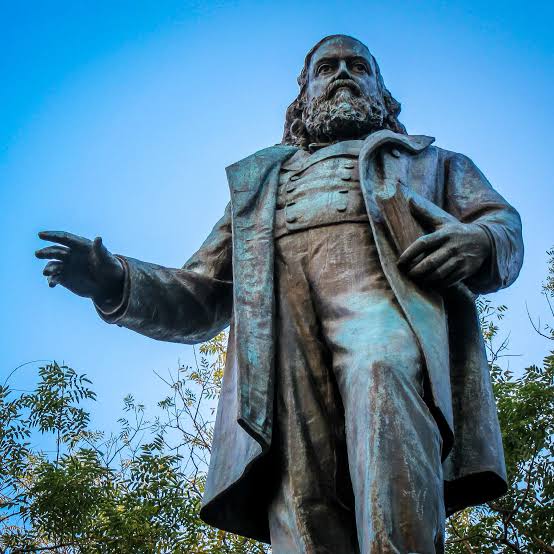Albert pike statue dc: general,reinstalled in DC,Morals and Dogma,Freemason

Statue of Confederate general toppled by protesters in 2020…Washington, D.C. Statue of Albert Pike, a Confederate general and influential Freemason in Washington, D.C. Today we will discuss about Albert pike statue dc: general,reinstalled in DC,Morals and Dogma,Freemason
Albert pike statue dc: general,reinstalled in DC,Morals and Dogma,Freemason
Albert Pike is one of the most controversial yet intellectually influential figures in American history. His name connects three powerful threads of nineteenth-century America: the Civil War, Freemasonry, and the struggle over how the nation remembers its past. The statue of Albert Pike in Washington, D.C., long a subject of debate, stands as both a memorial to his Masonic achievements and a reminder of his Confederate military service.
This article explores the life of Albert Pike, the story behind his statue in Washington, D.C., his Masonic writings—especially Morals and Dogma—and the political and cultural battles surrounding the statue’s removal, restoration, and reinstallation.
I. The Life of Albert Pike: Scholar, Soldier, and Freemason

Albert Pike was born in 1809 in Boston, Massachusetts. A gifted student and self-taught linguist, Pike excelled in classical studies and later moved south and west, eventually settling in Arkansas. There, he became a lawyer, writer, and intellectual voice in the young American frontier.
During the Civil War, Pike served as a brigadier general in the Confederate Army. His role was primarily diplomatic—he was tasked with recruiting Native American tribes to the Confederate cause—but his tenure was controversial. He was later accused of failing to control his troops during violent incidents, and his command ended under a cloud of suspicion.
After the war, Pike received a presidential pardon and returned to civilian life, devoting his energy to law, philosophy, and above all, Freemasonry. Over time, he became the most influential Masonic leader of the Scottish Rite’s Southern Jurisdiction, guiding its ritual and philosophy for more than three decades.
II. The Albert Pike Statue in Washington, D.C.
A. Dedication and Design
The Albert Pike statue was authorized by Congress in 1898 and dedicated in 1901. It was funded primarily by the Scottish Rite of Freemasonry as a tribute to Pike’s leadership within the order. Located in Judiciary Square, near the federal courthouse and the Metropolitan Police Department headquarters, the monument stood out as the only public statue in Washington dedicated to a Confederate general.
Sculptor Gaetano Trentanove created the bronze figure, which stands about eleven feet tall atop a seventeen-foot granite pedestal. The entire memorial rises roughly twenty-eight feet. Interestingly, the statue portrays Pike not in Confederate uniform but in civilian attire, holding a book—interpreted as Morals and Dogma—symbolizing his role as a scholar rather than a soldier.
B. Symbolism and Inscriptions
The statue’s inscription reads:
“ALBERT PIKE / Born 1809 – Died 1891”
Below his name appear the words: “AUTHOR – POET – SCHOLAR – SOLDIER – JURIST – ORATOR – PHILANTHROPIST – PHILOSOPHER.”
These descriptors highlight Pike’s intellectual and moral identity rather than his Confederate service. The design reflects how the Masonic fraternity sought to commemorate him—not as a general, but as a thinker and reformer of Freemasonry.
A bronze allegorical figure of “Faith” originally stood at the base, symbolizing enlightenment and moral virtue, further distancing the monument from Pike’s wartime role.
C. Location and Historical Status
The Pike statue was placed in Judiciary Square, a historically significant part of Washington filled with legal and governmental buildings. Managed by the National Park Service, the monument became part of the National Register of Historic Places in 1978 as part of the city’s Civil War monuments group.
While technically a Confederate memorial, it was framed as a Masonic monument—an ambiguity that would later fuel decades of controversy.
III. Albert Pike and Freemasonry
A. Pike’s Masonic Career
Albert Pike joined Freemasonry in the 1850s and rose through the ranks of the Scottish Rite, eventually becoming Sovereign Grand Commander of the Southern Jurisdiction. His impact on Freemasonry was profound. He rewrote rituals, systematized degree lectures, and infused the Scottish Rite with philosophical and moral depth.
Pike’s leadership transformed the Rite into a structured system of moral and esoteric study. His vision connected the degrees of Freemasonry with universal themes drawn from ancient philosophy, mythology, and comparative religion.
B. Morals and Dogma of the Ancient and Accepted Scottish Rite
In 1871, Pike published Morals and Dogma, a massive philosophical treatise covering the 32 degrees of the Scottish Rite. Each chapter presents moral lessons, historical commentary, and symbolic interpretation drawn from diverse traditions—Greek, Egyptian, Hebrew, Hindu, and others.
The work is dense, allegorical, and rich in symbolism. It was not intended for the general public but for initiates of the higher degrees. Freemasons regard it as one of the most significant intellectual contributions to modern Masonry.
Morals and Dogma emphasizes self-knowledge, virtue, and the pursuit of truth. Pike’s central theme is that moral progress arises from inner enlightenment rather than dogmatic religion or political power.
C. Influence and Controversy
Pike’s erudition earned him reverence within Freemasonry, but his views have also been criticized. Some passages in his writings reflect the racial and cultural prejudices of his time. Outside the fraternity, Morals and Dogma has been the subject of myth and conspiracy—especially claims that Pike advocated Luciferian worship, which mainstream Freemasons strongly reject as misinterpretations.
Today, Pike remains both a revered philosopher among Masons and a problematic figure in broader public history.
IV. Controversy and Removal of the Pike Statue
A. Early Opposition
The presence of a monument to a Confederate general in the nation’s capital has long been controversial. As early as the 1990s, D.C. officials petitioned Congress to remove the Pike statue. Critics argued that it was inappropriate for the capital to honor any Confederate officer, regardless of other achievements.
Supporters countered that the statue commemorated Pike’s Masonic and intellectual work, not his military service. The tension between these interpretations—Freemason versus Confederate—defined the debate for decades.
B. The 2020 Protests and Destruction
In June 2020, amid nationwide protests against racial injustice following the murder of George Floyd, demonstrators in Washington, D.C. toppled and burned the Pike statue. The event occurred on Juneteenth, a symbolic date marking the end of slavery in the United States.
Protesters viewed the statue as a lingering emblem of white supremacy, despite its Masonic intent. City leaders and federal authorities condemned the destruction but acknowledged the emotional power of the moment. The damaged bronze was removed and placed in storage by the National Park Service.
The fall of the Pike statue became one of the most visible acts in the national movement to reevaluate Confederate monuments.
V. Restoration and Reinstallation
A. Decision to Restore
In 2025, after several years of debate, the National Park Service announced plans to restore and reinstall the Albert Pike statue in Washington, D.C. The decision cited compliance with federal preservation laws and executive orders requiring the protection of federally owned monuments.
The restoration process involved repairing the bronze sculpture, reconstructing the granite base, and strengthening its foundations.
B. Public Reaction
The reinstallation announcement reignited controversy. Supporters argued that restoring the statue preserved an important piece of history and recognized Pike’s intellectual legacy. Critics saw it as a backward step—an attempt to sanitize or glorify a Confederate figure.
Prominent D.C. leaders called for the statue to be placed in a museum instead of a public square. Civil rights advocates described its return as “morally unacceptable,” while Masonic organizations emphasized that the monument was dedicated to Pike the philosopher, not Pike the general.
C. Contextualization and Interpretation
To address these concerns, plans were introduced to add interpretive plaques explaining Pike’s full biography—acknowledging both his contributions to Freemasonry and his Confederate past. Whether these contextual markers will satisfy public sentiment remains to be seen.
The reinstallation of the Pike statue has become a national test case for how societies reconcile the preservation of art and history with the need for moral accountability.
VI. The Broader Debate: Memory, Monuments, and Meaning
A. The Function of Monuments
Monuments are never neutral. They are statements about what a society values and chooses to remember. The Pike statue’s dual identity—Masonic philosopher and Confederate general—forces Americans to confront how complicated historical figures can be.
Should a monument celebrate a person’s best qualities while ignoring their flaws? Or should public spaces reflect inclusive values that speak to the present as well as the past?
B. The “Lost Cause” and Historical Context
Many Confederate monuments were erected decades after the Civil War, during the Jim Crow era, to reinforce Southern identity and white dominance. The Pike statue, however, was funded by Freemasons, not the state, and intended to honor intellectual achievement. Nevertheless, its timing—1901—coincides with that same era of racial retrenchment.
This overlap raises important questions about intent versus impact: even if the Masons’ motives were philosophical, the broader cultural meaning of commemorating a Confederate general in Washington carries heavy symbolic weight.
C. Preservation Versus Progress
Supporters of the statue’s restoration argue that removing or destroying monuments erases history. Opponents respond that relocation or reinterpretation does not erase history—it contextualizes it.
The Pike statue illustrates this dilemma perfectly. Its physical restoration may preserve art and heritage, but without thoughtful interpretation, it risks perpetuating misunderstanding.
VII. Freemasonry, Philosophy, and Pike’s Legacy
Albert Pike’s Masonic teachings still influence the Scottish Rite today. Within the fraternity, he is remembered as a man of letters and a seeker of truth. His intellectual curiosity and dedication to moral improvement resonate with Freemasons worldwide.
Yet modern Freemasonry, like society itself, has evolved. Today’s Masons emphasize equality, tolerance, and civic virtue—values that sometimes contrast sharply with aspects of Pike’s nineteenth-century worldview.
The renewed discussion of Pike’s life encourages Freemasonry to confront its own history and continue its journey toward inclusivity. The Masonic fraternity’s willingness to acknowledge Pike’s complexities may serve as a model for how institutions can honor tradition while embracing reform.
VIII. Lessons from the Pike Statue Debate
The saga of the Albert Pike statue reveals several broader truths about history and memory in the United States:
No legacy is simple. Pike was at once a poet, lawyer, general, and philosopher. His life embodied both the best and worst of his century.
Public monuments express public values. Erecting, removing, or reinstalling a statue always conveys what a society stands for at that moment.
Interpretation matters. Whether a statue is seen as heritage or offense depends largely on how it is presented and explained.
Dialogue is essential. The controversy around Pike encourages discussion about identity, justice, and historical truth—conversations vital to civic growth.
IX. The Future of the Albert Pike Statue
As of 2025, the restored Albert Pike statue stands once again in Judiciary Square, surrounded by new interpretive materials that explain both his Masonic legacy and his Confederate connection.
Whether the monument will remain there indefinitely is uncertain. For some, it is an educational artifact that helps the public engage with complex history. For others, it remains a painful reminder of a divisive past.
The debate is likely to continue, and perhaps that is its most meaningful function: to keep alive the dialogue about how America defines heroism, memory, and reconciliation.
Conclusion
The Albert Pike statue in Washington, D.C., represents far more than one man’s likeness. It embodies the tensions between knowledge and power, remembrance and regret, preservation and progress.
Albert Pike was a scholar of vast intellect and a leader of Freemasonry whose writings, especially Morals and Dogma, shaped generations of initiates. Yet he was also a Confederate general who fought for a cause that sought to preserve slavery. His memorial captures this contradiction in bronze and stone.
The reinstallation of the statue in 2025 challenges the nation to confront—not conceal—its complex history. Whether regarded as a monument to Freemasonry, a relic of the Confederacy, or a test of historical conscience, the Albert Pike statue invites reflection on how we remember our past and what we choose to honor in our public spaces.
Ultimately, the statue’s story reminds us that history is not static. It is a living conversation, and every generation must decide how to balance truth, justice, and memory.
How useful was this post?
Click on a star to rate it!
Average rating 0 / 5. Vote count: 0
No votes so far! Be the first to rate this post.
About the Author
usa5911.com
Administrator
Hi, I’m Gurdeep Singh, a professional content writer from India with over 3 years of experience in the field. I specialize in covering U.S. politics, delivering timely and engaging content tailored specifically for an American audience. Along with my dedicated team, we track and report on all the latest political trends, news, and in-depth analysis shaping the United States today. Our goal is to provide clear, factual, and compelling content that keeps readers informed and engaged with the ever-changing political landscape.




